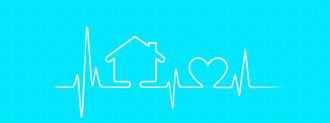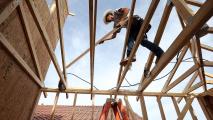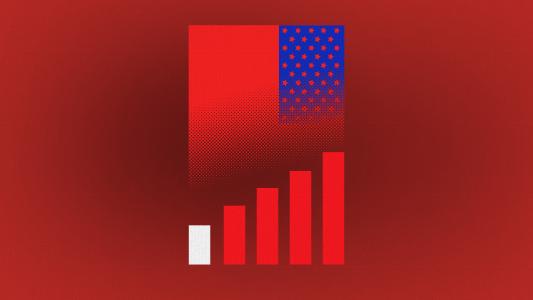Smart home technology may call to mind quirky upgrades that automate lighting, climate, or entertainment. But now a true smart home, designed from the ground up, can be useful for your health — even a lifeline. The next generation of wellness technology is moving from wearable health tracking devices to ones that monitor your well-being from the walls of your home.
“We can use the home to get into your guts, your health and your blood system,” Kobi Karp told the New York Times. Karp is a Miami-based architect who designs luxury homes that cost up to eight figures and are considered among the best in environmentally sustainable architecture design. Now, when it comes to designing homes, he is also considering the “sustainable” nature of the occupant’s well-being.
According to the New York Times, Karp’s designs might include smart home features like SensFloor — floorboards embedded with sensors that detect falls. It was designed initially for care facilities for the elderly, but Karp is considering incorporating it into homes with seizure-prone residents. The technology can send an alert or call for help when it recognizes a fall, possibly prolonging the time the elderly can safely live alone.
Another potential design feature is the Poseidon Smart Mirror, which can check the homeowner’s vision, as well as play music or monitor the bath’s water temperature.
AI-powered devices that monitor health are also trending in hospitals, accelerating the “smart hospital” trend.
“We have the ability to build technologies into the physical spaces where health care is delivered to help cut the rate of fatal errors that occur today due to the sheer volume of patients and the complexity of their care,” Arnold Milstein, a professor of medicine at Stanford’s Clinical Excellence Research Center said in a statement.
Ambient smart sensors can monitor a hospital room, for example, by alerting clinicians when they fail to sanitize their hands — a major cause of hospital-borne infections. Milstein co-directs the Stanford Partnership in AI-Assisted Care, where technologists, nurses, and doctors partner to create ambient intelligence technology to help manage the large numbers of people staying in hospitals.
Ambient intelligence technology uses infrared sensors and machine learning to detect such things as twitching under the bedsheets — a potential sign of discomfort or distress — or falls and accidents. The infrared sensors produce a silhouette image, which the AI is trained to interpret and alert nurses when it detects something concerning.
“We are in a foot race with the complexity of bedside care,” Milstein said. “By one recent count, clinicians in a hospital’s neonatal intensive care unit took 600 bedside actions, per patient, per day. Without technology assistance, perfect execution of this volume of complex actions is well beyond what is reasonable to expect of even the most conscientious clinical teams,” he said.
The trend toward home-based and personalized touchless health tracking devices may be spurred on by COVID-19, providing people with the opportunity to monitor their health without visiting a doctor. But individualized wellness technology has been evolving for some time — from smartphones detecting mental health disorders to emotion-sensing technology that uses machine learning to inform personalized healthcare.
As we spend more time at home than ever before, we’ll see increasing interest in sensors and sterilization devices.
David Shrier
Already, wearables can track your sleeping patterns or heart rate. Cell phones can monitor typing patterns to detect Parkinson’s disease. And a health app could analyze a selfie to detect heart disease. But wiring that technology directly into homes — outfitting mirrors, walls, and floors with health-tracking electronics — could be a level up in innovation.
David Shrier, MIT’s Media Lab futurist, tells Luxury Defined that homes of the future may include UV disinfection lights to sanitize surfaces, temperature-taking sensors, and toilets that analyze their contents. Imagine that — everyone will be inviting themselves over for dinner.
“The move is towards home technology that can collect medical data and share it with your doctors,” said Shrier.
With wearable technology, cell phone wellness apps, and smart home devices, the data needs to go somewhere to provide useful feedback. It can be sent to healthcare data and analytics services, like Telus Health. Given the steady relationship people have with their technology, that data could provide a more comprehensive picture of physical and mental health than a single visit to the doctor.
While some smart home devices, like the Ecobee SmartThermostat or Amazon Echo, are becoming more mainstream, house-wide upgrades that monitor health are still too costly for most people. And, as with any technology, privacy concerns abound. Could your data be used for research without your permission? Could others gain access and exploit your data for profit? And do we really want doctors to know about everything that goes into the toilet?
Shrier says that the pandemic may sway the public interest.
“As we spend more time at home than ever before, we’ll see increasing interest in sensors and sterilization devices. We’ll also see the introduction of intelligent tools that are aware of our medical profiles and needs and are able to monitor our health continually. And, as with all innovations, we will see them first at the luxury end of the market.”
We’d love to hear from you! If you have a comment about this article or if you have a tip for a future Freethink story, please email us at [email protected].






